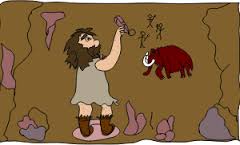 My French 3 students will spend 4th quarter learning about a few different eras in French history. I haven’t taught this content for a few years, but when I did so my students were engaged by the project-oriented approach to the mini-units. In most cases my students know little about early man’s way of life and are naturally interested in it. In addition, the numerous prehistoric caves in France make this content-based unit culturally relevant.
My French 3 students will spend 4th quarter learning about a few different eras in French history. I haven’t taught this content for a few years, but when I did so my students were engaged by the project-oriented approach to the mini-units. In most cases my students know little about early man’s way of life and are naturally interested in it. In addition, the numerous prehistoric caves in France make this content-based unit culturally relevant.
In order to provide the students with important background knowledge about prehistoric humans, I will begin with an interpretive task in which the students will read an article about two prehistoric people—Cro-Magnon and Neanderthal (p.1, p. 2). Because it is my intention to provide content knowledge, rather than assess in-depth comprehension, I am providing only a supporting-detail task for this article. The students will respond in French in order to prepare them for next year’s assessments which will all be in French, as well as to enable my recent non-English-speaking new student to fully participate in the lesson. After the reading activity, I will play part of a Ce n’est pas Sorcier video about Neanderthals. Here’s the document with these activities (prehistoryunit) In order to familiarize the vocabulary for this unit (vocabulary pics), we will play Password. I have also chosen to insert a quick lesson on relative pronouns here. I have done very little direct instruction of grammatical structures this year, and most of my students are correctly using qui/que, but I wanted to do a brief presentation to reinforce their understanding. I will also introduce dont, which they will most likely not be able to use correctly for some time, but might at least recognize after this lesson.
After these activities to develop the students’ background knowledge and vocabulary for this content, I will move onto the project portion of the unit. As the packet (prehistory project ) explains, I will give each pair of students a photograph of a prehistoric artifact used by either Neanderthal or Cro-Magnon people. This Google Presentation contains the photographs I will use: https://docs.google.com/presentation/d/1aVwVV-KUvlAmI5kMQvIb8K0l4l9jIJPRZzZvUI8cy2Y/edit?usp=sharing and this document (slide links) lists the sites where I found the pictures, to serve as a key. The students will begin by filling in a graphic organizer with their hypotheses regarding the object. The students will first jot their own ideas in the graphic organizer, and then discuss their ideas with their partner, adding his/her ideas to the table. On the following day, the students will read articles about various aspects of prehistoric life in order to support or refute their hypotheses. Because I have a collection of children’s books about prehistory, I will photocopy relevant pages and make them available to the students. While scanning all of the pages I will use is time-prohibitive at this point, this step could easily be completed using online resources. As the students research, they will fill in the graphic organizer with information that either supports or refutes their hypotheses about the objects. They will then share their information, so that each has a completed graphic organizer with both of their research findings. The students will then use the information they have recorded to write a letter to a prehistoric art dealer to whom they would like to sell their artifact. They will then present their information orally to the art dealer (me), answering any questions that “I” may have. As a final assessment the students will complete these IPA-style interpretive tasks on an article and video about Lascaux (Lascaux IPA). While I have included pdf’s for the relevant pages of the article (p. 10, p. 11, p.12, p. 13, p. 14, p. 15), you will also find a link to a site that will enable you to buy a copy of the article in its entirety. I was thrilled to find the video that I have used here. Not only does it include wonderful images of Lascaux, but it is narrated by elementary children which will make it comprehensible for my students.
